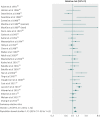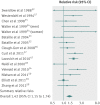Cutaneous melanoma attributable to sunbed use: systematic review and meta-analysis
- PMID: 22833605
- PMCID: PMC3404185
- DOI: 10.1136/bmj.e4757
Cutaneous melanoma attributable to sunbed use: systematic review and meta-analysis
Abstract
Objective: To estimate the burden of melanoma resulting from sunbed use in western Europe.
Design: Systematic review and meta-analysis.
Data sources: PubMed, ISI Web of Science (Science Citation Index Expanded), Embase, Pascal, Cochrane Library, LILACS, and MedCarib, along with published surveys reporting prevalence of sunbed use at national level in Europe.
Study selection: Observational studies reporting a measure of risk for skin cancer (cutaneous melanoma, squamous cell carcinoma, basal cell carcinoma) associated with ever use of sunbeds.
Results: Based on 27 studies ever use of sunbeds was associated with a summary relative risk of 1.20 (95% confidence interval 1.08 to 1.34). Publication bias was not evident. Restricting the analysis to cohorts and population based studies, the summary relative risk was 1.25 (1.09 to 1.43). Calculations for dose-response showed a 1.8% (95% confidence interval 0% to 3.8%) increase in risk of melanoma for each additional session of sunbed use per year. Based on 13 informative studies, first use of sunbeds before age 35 years was associated with a summary relative risk of 1.87 (1.41 to 2.48), with no indication of heterogeneity between studies. By using prevalence data from surveys and data from GLOBOCAN 2008, in 2008 in the 15 original member countries of the European Community plus three countries that were members of the European Free Trade Association, an estimated 3438 cases of melanoma could be attributable to sunbed use, most (n=2341) occurring among women.
Conclusions: Sunbed use is associated with a significant increase in risk of melanoma. This risk increases with number of sunbed sessions and with initial usage at a young age (<35 years). The cancerous damage associated with sunbed use is substantial and could be avoided by strict regulations.
Conflict of interest statement
Competing interests: All authors have completed the ICMJE uniform disclosure form at
Figures





Comment in
-
More evidence of harms of sunbed use, particularly for young people.BMJ. 2012 Oct 2;345:e6101. doi: 10.1136/bmj.e6101. BMJ. 2012. PMID: 23033410 No abstract available.
-
Sunbed use increases risk of melanoma; risk increases with greater number of sessions and first use at younger age.Evid Based Nurs. 2013 Oct;16(4):107-8. doi: 10.1136/eb-2012-101047. Epub 2013 Jan 15. Evid Based Nurs. 2013. PMID: 23321278 No abstract available.
References
-
- Schneider S, Krämer H. Who uses sunbeds? A systematic literature review of risk groups in developed countries. J Eur Acad Dermatol Venereol 2010;24:639-48. - PubMed
-
- Paul CL, Girgis A, Tzelepis F, Walsh RA. Solaria use by minors in Australia: is there a cause for concern? Aust N Z J Public Health 2004;28:90. - PubMed
-
- Paul CL, Stacy F, Girgis A, Brozek I, Baird H, Hughes J. Solaria compliance in an unregulated environment: the Australian experience. Eur J Cancer 2005;41:1178-84. - PubMed
-
- Lim HW, James WD, Rigel DS, Maloney ME, Spencer JM, Bhushan R. Adverse effects of ultraviolet radiation from the use of indoor tanning equipment: time to ban the tan. J Am Acad Dermatol 2011;64:893-902. - PubMed
Publication types
MeSH terms
LinkOut - more resources
Full Text Sources
Medical
